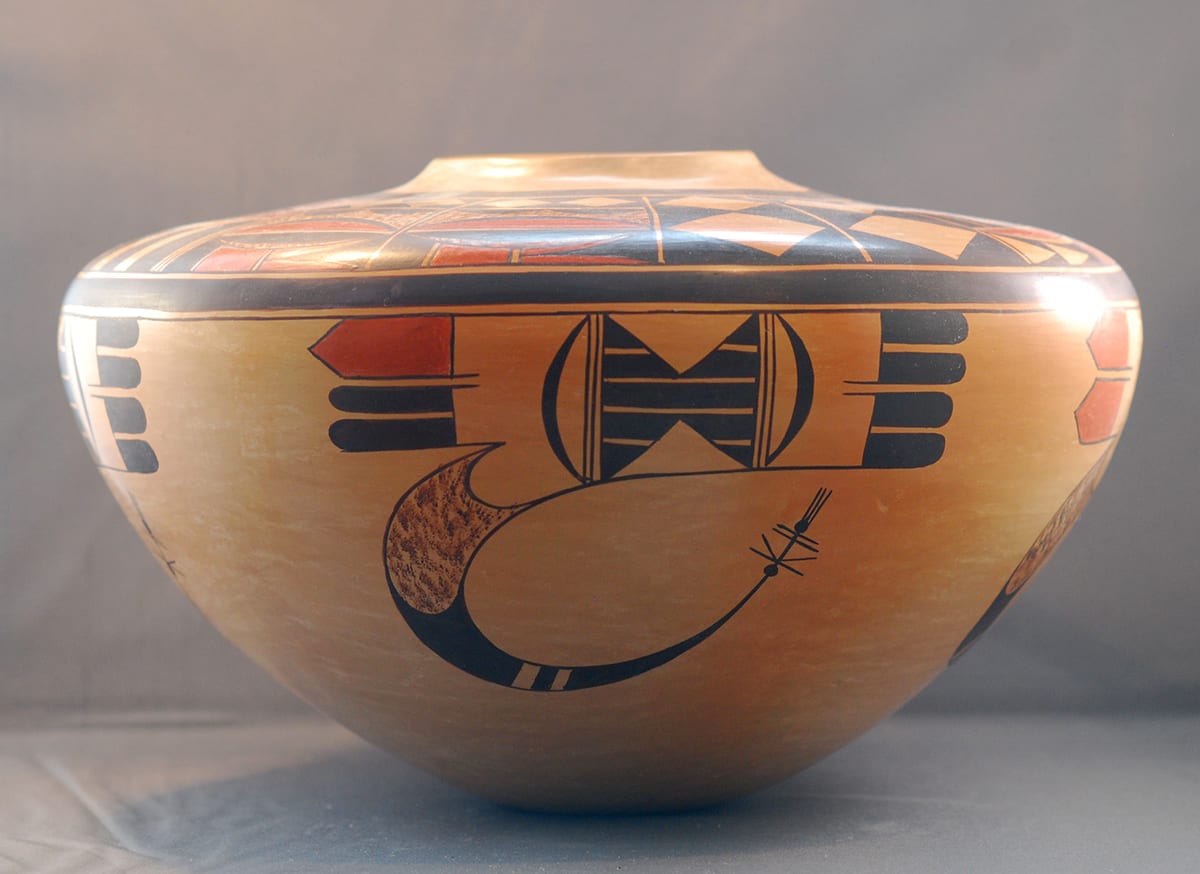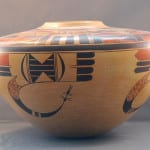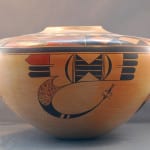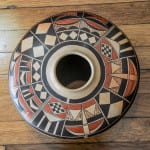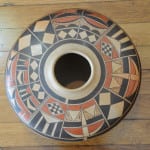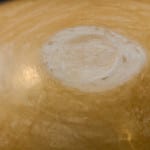This is a large jar with an unusual and spectacular shape that Rachel uses to show off a design that is both intricate and simple.
The iconic Nampeyo jar is a flat-toped “flying saucer” shape seedpot, which is a very difficult form to construct since the top half is difficult to support when the coiled clay is wet. (See 2005-16 in this collection.) Rachel has removed the top of this Nampeyo form and laid it over the wide mouth of a deep bowl, thus providing her not only a wide horizontal surface to decorate but also space for more decoration on the large vertical walls of the vessel. The top and sides of the pot are painted with quite different design strategies.
A short neck protrudes from the center of the vessel and below it is painted a wide, black, encircling band with a break line. At the maximum dimension of the pot, where the top of the jar joins the lip of the bowl, there is a second wide encircling band with a break, though the breaks in these elements do not line up. On opposite sides of the top, there is a gap in the decoration and four thin black lines run between these two wide encircling bands, which form a pattern like a three-lane road. Together, these thin lines form an axis that divides the decoration on the top surface of the jar into two equal areas, each with its own design pattern. If you look directly down at the top of this jar so that the three-lane axis is vertical and the break lines are to the right, I am calling the right half of the decoration “Design #1” and the left half “Design #2.”
A first glance the top of the jar seems like a jumble of carefully painted elements. In time, a clear pattern emerges.
Design #1 has three elements. At the center is a black area with two imbedded unpainted diamond shapes with their points touching. Flanking this pattern on either side is a sort of Halloween pumpkin face with triangular eyes, a thin triangular nose and a wide grinning mouth formed from a lunette of red paint for a mouth and unpainted lips. Continuing outward from the center is the final painted pattern on either end of design #. The top half is painted red with an imbedded checkerboard pattern that continues the diamond motif; the bottom half is an unpainted triangle with its point toward the base of the jar, followed by four broad black stripes. This lower section looks like a flag hung as a banner.
Design #2 is also formed of three design elements, but here they are presented in pairs. The first pair to the right of the three-lane axis is subdivided into four areas that echo the design elements in Design #1: a black area with two imbedded unpainted diamonds, the flag banner, a red strip toping an unpainted chevron and, at the bottom, a reinterpretation of that pumpkin mouth. The second pair of panels in Design #2 is the same black area with imbedded unpainted diamonds seen in Design #1. Finally, to the left, is a final pair of designs. Each is topped with the familiar black area with imbedded unpainted diamonds. Below is an area with red over black lunettes forming a sort of eye image. Extra space is filled with lightly stippled paint. Finally, at the bottom of this section is a truncated avian image with thin red tail feathers and a red body, all set against a black background.
The overall design of the jar top is elegant, but very complicated. The overall pattern of design provides a measure of coherence and order. The design of white unpainted diamonds against the black background is a common theme. Three large versions of this motif are found: one imbedded in Design #1 and two renditions directly opposite in Design #2. This motif thus ties the two halves together. The remaining four sections of Design #2 repeat this diamond pattern as their top element, thus continuing this theme across all six segments of that half of the top and unifying that section of the design. Moreover, two of the five segments in Design #1 contain a variation of a red lunette; four of the six segments in Design #2 contain this element, thus further unifying the overall design. It is complicated and busy, but also ordered and unified.
In contrast to the busy top design, the sides of the jar are decorated with four identical renditions of Nampeyo’s “Bird Hanging from Sky Band” design. (See 1993-04 and the Bird Hanging from Sky Band Design in the Index of Categories for other examples.)
Rachel presents a simple form of the design. Particularly elegant are the ball and line motif at the end of the curvilinear arc. According to Fewkes (1919:241-242, and plate 78), this design represents a prayer offering (Nakwakwoci), which consists of breast feathers tied in a proscribed way to the end of a string. A Sikyatki version of this design is on shard 2012-11a in this collection.
As outlined in great detail when discussing bowl 1993-04 in Appendix B, the “Bird Hanging from Sky Band” design incorporates many of the iconic design strategies of the mature Nampeyo. To great effect, Rachel has captured those strategies on the sides of bowl 2012-23—especially a tension between heavy linear and delicate curvilinear elements, and the use of empty (negative) space to frame the painted image and give the avian motif room to fly.
The combination of a busy, complex design on the top surface and a simple calm design on the sides of pot 2012-23 is unusual and startles the eye. In the hands of a less-talented artist, this strange mixture would look clumsy and haphazard. Here, the effect is intriguing and delightful.

